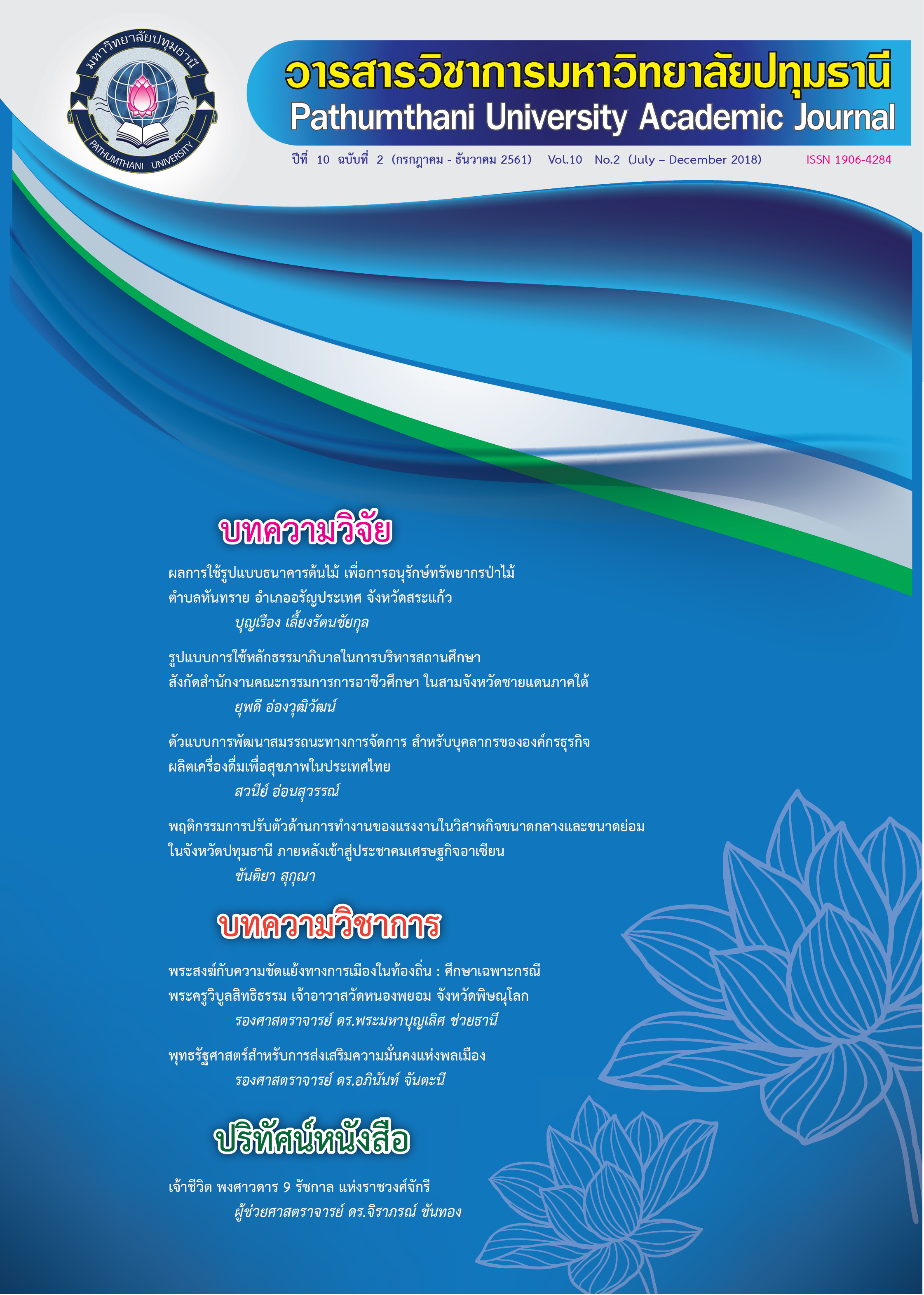ความสำเร็จในการพัฒนาสังคมขององค์กรรับทุนกฬีามวยไทย : กรณีศึกษาโครงการลานกีฬามวยไทยต้านภัยยาเสพติด ลานมวยครูเสือ
Keywords:
มวยไทย, พัฒนาสังคม, องค์กรรับทุนAbstract
The propose of this research aim to (1) study management factors contributing to social development of the Lan Muay Thai Krua Suea Project; (2) to study the success of social development of the above project; and (3) to study the benefit gained by participants from the establishment of the project. The population of this study were divided into two group : (1) Muay Thai experts and trainers from four Muay Thai circles of Lan Muay Krua Suea : Wang Thong Lang, Klong Toey, Wat Cholpratan Rang Sarit (Main Royal Temple), and Krung Thonburi. Totaling 28 persons, from whom data were gathered via in-depth interviews; (2) 182 youths, parents and other participants in the project from whom data were collected via questionnaires. The data from above two group were then analyzed in terms of content and statistical analyses. It was found from the study that the factors contributing to the success consist of (1) Community cooperation; (2) management was organized in a form of philanthropies organization; (3) building understanding among parents; (4) there excited “Krua Muay” with conscientiousness and spirit of being Krua Muay trainers; (5) personnel involved were trusted; (6) activity assuagements were jointly carried out between the project and communities; (7) budget. The success of Krua Suea project results in benefits gained from all walks of life, ranging from those to youths, together with their body and mind, including using leisure time wisely; to their families in continuously directing their sons correctly; to communities; to society by creating quality human capital for the development of the country, including preserving Muay Thai martial arts.
References
2. กระทรวงสาธารณสุข. (2560). วิวัฒนาการทางการแพทย์. [ออนไลน์]. เข้าถึงได้จาก http://mophaccess.moph.go.th/index.php/2013-07-15-03-58-59.
3. กิติพัฒน์ นนทปัทมะดลุย์. (2553). ทฤษฎีสังคมสงเคราะห์ร่วมสมัย. กรุงเทพมหานคร : สำนักพิมพ์ มหาวิทยาลยัธรรมศาสตร์.
4. คณะกรรมาธิการโลกว่าด้วยวัฒนธรรมและพัฒนา. (2541). วัฒนธรรมอันหลากสีของมนุษยชาติ : รายงานของ คณะกรรมาธิการโลกว่าด้วยวัฒนธรรมและการพัฒนา. กรุงเทพมหานคร : ส านักเลขาธิการคณะกรรมการ แห่งชาติว่าด้วยการศึกษา วิทยาศาสตร์ และวฒันธรรมแห่งสหประชาชาติ กองการสัมพันธ์ต่างประเทศ กระทรวงศึกษาธิการ.
5. โครงการลานกีฬามวยไทยตา้นภัยยาเสพติด . (2560). ประวัติความเป็นมา วัตถุประสงค์ และเป้าหมายของ โครงการลานกีฬามวยไทยต้านภัยยาเสพติด. [ออนไลน์]. เข้าถึงได้จาก http://www.ptu.ac.th/lanmuay/about1.php
6. พระครูปลัดสราวุธ ฐิตปญโฺญ. (2558). “พระสงฆ์กับการพัฒนาสังคม”. วารสารบัณฑิตศึกษาปริทรรศน์ วิทยาลัยสงฆ์นครสวรรค์. ปีที่ 3 ฉบับที่ 2. พฤษภาคม-สิงหาคม 2558. นครสวรรค์ : วิทยาลัยสงฆ์นครสวรรค์.
7. พระมหาสมเกียรติ พวงใย. (2552). วิถีชีวิตการดำเนินชีวิตที่เหมาะสมของนักมวยไทย. วิทยานิพนธ์ปริญญาศิลปศาสตรมหาบัณฑิต. มหาวิทยาลัยมหาสารคาม.
8. พวงรัตน์ ทวีรัตน์. (2540). วิธีการวิจัยทางพฤติกรรมศาสตร์และสังคมศาสตร์. กรุงเทพมหานคร : สำนักทดสอบทาง การศึกษาจิตวิทยา มหาวิทยาลัยศรีนครินทรวิโรฒประสานมิตร.
9. โพธิ์สวัสดิ์ แสงสว่าง. (2522). พัฒนาการกีฬามวยไทย. วิทยานพินธ์ปริญญาครุศาสตรมหาบัณฑิต. จุฬาลงกรณ์มหาวิทยาลัย.
10. สถาบันอนุรักษ์ศิลปะมวยไทย กรมพลศึกษา กระทรวงการท่องเที่ยวและกีฬา. (2555). ศิลปะมวยไทย. [ออนไลน์]. เข้าถึงได้จาก http://www.dpe.go.th/content/file/article/0224161456316608.pdf
11. สุรวัฒน์ ปัตตานี. (2550). แนวทางการพัฒนามวยไทยอาชีพในภาคตะวันออกเฉียงเหนือตามการรับรู้ของนักมวย และผู้ฝึกสอนกีฬามวยไทย. วิทยานิพนธ์ปริญญาศิลปศาสตรมหาบัณฑิต สาขามวยไทยศึกษา. วิทยาลัยมวย ไทยศึกษา มหาวิทยาลัยราชภัฏหมู่บ้านจอมบึง.
12. สำนักงานส่งเสริมกองทุนสนับสนุนการสร้างเสริมสุขภาพ. (2559). โครงการที่ได้รับอนุมัติงบประมาณ. [ออนไลน์]. เข้าถึงได้จาก http://www.thaihealth.or.th/Content/33187โครงการที่อนุมัติตั้งแต่ ปีงบประมาณ%202557.html
13. Babiak, K., & Wolfe, R. (2009). Determinants of corporate social responsibility in professional sport: internal and external factors. Journal of Sport Management, 23(6), 717-742.
14. Bridges, F., & Roquemore L. (1996). Management for athletic sport administration : Theory and practice. 2nd ed. Decatur, GA : ESM Books.
15. Bonavia, Martin, Tomas. (1998). Managers’ Behavior and Development of Organizational Participation. Ph.D. Dissertation. Universitat De Valencia (Spain).
16. Charities Aid Foudation. (2011). World Giving Index 2011.
17. Guoying Yuan, Houzhong Jin & Hongquan Li. (2011). Theoretical Research on Building Communities of Mixng Sport into Life.
18. Henri Fayol. (1916). General and Industrial Management. London : Sir Isaac Pitman and Sons.
19. Krejcie, R.V.,and Morgan D.W. (1970). Determining Sample Size for Research Activities. Psycholological Measurement. R.P.
20. Misra and M. Honjo, eds. (1981). Changing Perception of Development Problems. 10 vols. Nagoya, Japan: U.N. Centre for Regional Development.
Downloads
Published
How to Cite
Issue
Section
License
บทความที่ได้รับการตีพิมพ์เป็นลิขสิทธิ์ของวารสารมหาวิทยาลัยปทุมธานี
ข้อความที่ปรากฎในบทความแต่ละเรื่อง เป็นความคิดเห็นส่วนตัวของผู้เขียน กองบรรณาธิการไม่จำเป็นต้องเห็นด้วยเสมอไป และไม่มีส่วนรับผิดชอบใด ๆ ถือเป็นความรับผิดชอบของผู้เขียนแต่เพียงผู้เดียว



